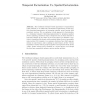Free Online Productivity Tools
i2Speak
i2Symbol
i2OCR
iTex2Img
iWeb2Print
iWeb2Shot
i2Type
iPdf2Split
iPdf2Merge
i2Bopomofo
i2Arabic
i2Style
i2Image
i2PDF
iLatex2Rtf
Sci2ools
ECCV
2004
Springer
2004
Springer
Temporal Factorization vs. Spatial Factorization
The traditional subspace-based approaches to segmentation (often referred to as multi-body factorization approaches) provide spatial clustering/segmentation by grouping together points moving with consistent motions. We are exploring a dual approach to factorization, i.e., obtaining temporal clustering/segmentation by grouping together frames capturing consistent shapes. Temporal cuts are thus detected at non-rigid changes in the shape of the scene/object. In addition it provides a clustering of the frames with consistent shape (but not necessarily same motion). For example, in a sequence showing a face which appears serious at some frames, and is smiling in other frames, all the "serious expression" frames will be grouped together and separated from all the "smile" frames which will be classified as a second group, even though the head may meanwhile undergo various random motions.
Computer Vision | Consistent Motions | Consistent Shape | Consistent Shapes | ECCV 2004 | Multi-body Factorization | Various Random Motions |
| Added | 15 Oct 2009 |
| Updated | 15 Oct 2009 |
| Type | Conference |
| Year | 2004 |
| Where | ECCV |
| Authors | Lihi Zelnik-Manor, Michal Irani |
Comments (0)

